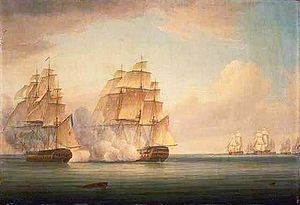Allemand's expedition of 1805
| Action of 26 September 1805 | |||||||
|---|---|---|---|---|---|---|---|
| Part of the Napoleonic Wars | |||||||
 Magnanime engaging HMS Calcutta, Thomas Whitcombe, National Library of Australia |
|||||||
|
|||||||
| Belligerents | |||||||
|
|
|
||||||
| Commanders and leaders | |||||||
| Contre-Admiral Zacharie Allemand | Captain Daniel Woodriff | ||||||
| Strength | |||||||
| 5 ships of the line, 2 frigates and 2 corvettes. Only Armide and Magnanime engaged. | fourth rate HMS Calcutta | ||||||
| Casualties and losses | |||||||
| negligible | 6 killed, 6 wounded, Calcutta and merchant ship Brothers captured | ||||||
Allemand's expedition of 1805, often referred to as the Escadre invisible (invisible squadron) in French sources, was an important French naval expedition during the Napoleonic Wars, which formed a major diversion to the ongoing Trafalgar Campaign in the Atlantic Ocean. With the French Mediterranean Fleet at sea, Emperor Napoleon I hoped to unite it with the French Atlantic Fleet and together form a force powerful enough to temporarily displace the British Royal Navy Channel Fleet for long enough to allow an invasion force to cross the English Channel and land in Britain. In support of this plan, the French squadron based at Rochefort put to sea in July 1805, initially with the intention that they would join the Atlantic Fleet from Brest. When this fleet failed to put to sea, the Rochefort squadron, under Contre-Admiral Zacharie Allemand, went on an extended raiding cruise across the Atlantic, both to intercept British trade left lightly defended by the concentration of British forces in European waters and with the intention of eventually combining with the French Mediterranean Fleet then blockaded in Spanish harbours.
On 25 September, Allemand achieved a major success when his squadron, while waiting for a convoy from the Leeward Islands, encountered a seven-ship convoy from the island of Saint Helena. The convoy's commander, Captain Daniel Woodriff in the fourth rate HMS Calcutta, sought to interpose his ship between the French squadron and his convoy and was captured after a fierce battle. All except one of convoy escaped, and by deliberately drawing the French away from his own convoy's direction, he had saved the Leewards Islands convoy from attack as well. After the battle, Allemand was forced to conduct repairs at Tenerife, sailing again on 17 October, four days before the French Mediterranean Fleet was destroyed at the Battle of Trafalgar. With the planned invasion impossible, Allemand began commerce raiding in the Eastern Atlantic, capturing 43 merchant ships during his cruise and successfully disrupting the British blockade of Cadiz. This had an unintended but significant effect on the Atlantic campaign of 1806, resulting eventually in the Battle of San Domingo in February 1806. Allemand returned to Rochefort on 23 December, having not lost a single ship during the expedition.
...
Wikipedia
